Your favorite slasher movie franchise has met its fateful “Ends.” Hopefully, you’ve already seen the film because spoilers abound in this detailed, in-depth dissection of Halloween Ends and the rest of David Gordon Green’s Halloween Trilogy in this essay. I have tried to let a fair amount of time pass before publishing this, having written the bulk of it right after watching the film in mid-October. If you have seen it, you’re likely searching for answers pertaining to the head-scratching finale of Green’s Trilogy, and, believe it or not, there’s a lot to unpack. However, Before we get into anything, I want to pivot a moment to a long time ago in a galaxy far, far away…
The Familiar Shape of Nostalgia
I felt slightly disappointed when I left the theater after seeing the 2015 Star Wars sequel, The Force Awakens. While everyone I had exited the movie with was raving about JJ Abrams’ film like it was unlike anything they’d seen before, I was sullen. It wasn’t the loss of Han or the absence of Luke that discouraged my enjoyment, but the nagging question in my mind was, “Was this the best they could do?” The film was a near-mirrored template of A New Hope, and while fans and critics connected with the nostalgic aspects of the film, to me, it just felt like another reboot. When 2018’s Halloween was released, I had some similar reservations.
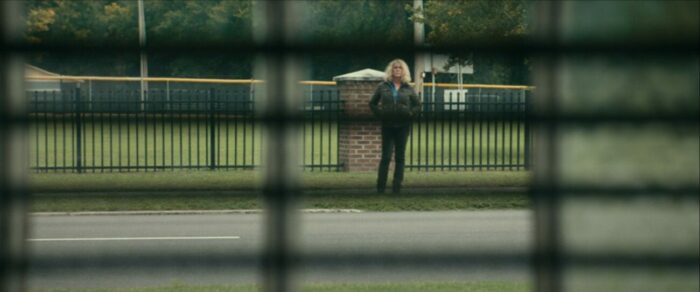
While Star Wars and Halloween are comparably apples and oranges, they do share a commonality in using a reboot template borrowing heavily from their beloved predecessors to achieve a sense of connection with nostalgic viewers while introducing new characters forced to repeat events we’ve seen, acting like the addition of those characters equates to a new story. In this regard, I believe the 2018 Halloween is far better than The Force Awakens. It has more originality breathed into its screenplay as it flips the script halfway through, allowing writers Jeff Fradley, Danny McBride, and David Gordon Green to deviate more from the beaten path and traverse a new one.
So, here we are at Halloween Ends, out of the fathomable depths of what we’re accustomed to in other Halloween movies. Just as The Last Jedi divided audiences and The Rise of Skywalker begs to be forgotten, Halloween Kills and Halloween Ends feel like the horror genre versions of what transpired when the Star Wars sequels attempted to enter new territory before course correcting toward familiarity.
What’s uniquely troubling about Halloween Ends is the POV character for much of the film is someone we don’t meet sooner. Corey (Rohan Campbell) is introduced at the start of Ends as a babysitter for a privileged little suburban brat, Jeremy (Jaxon Goldenberg), whom he accidentally sends careening over a third-floor balcony straight to his death when the boy’s prank to trap his authority figure in the attic backfires. You’d think after two films of an outlined Trilogy, there may have been an opportunity to include Corey more naturally into the story, and judging from the events that occur, it would give Green’s Trilogy a better arc since Corey is the balancing Sith to Allyson’s (Andi Matichak) Jedi.
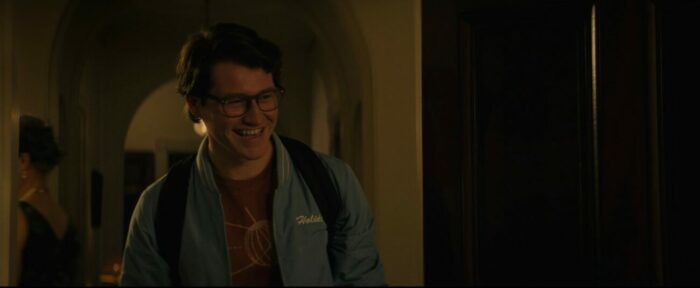
From the start, the movie mirrors scenes from 1978’s Halloween, most notably in the opening. Jeremy’s parents are going to a costume party and eventually arriving home just as the accident has happened. The staircase and mirror in the hallway easily resemble the Myers murder house setup, while the living room area resembles that of Tommy Doyle’s house. A key mashup in understanding the puzzle box of subtext that is Halloween Ends.
Corey and Jeremy are watching Carpenter’s The Thing on TV, a modern classic instead of the 1951 Christian Nyby film Carpenter’s movie was based on that Tommy Jarvis watches in the original 1978 Halloween. While a science fiction film marathon plays on television, the scene is intercut with Tommy hiding behind a curtain, who becomes mortified by the shadowy figure lurking across the street. The memorable scene highlights the coming end of unlocked doors in suburban neighborhoods by showing the duality of nuclear panic era sci-fi horrors on a tv screen. The audacious dilemmas of humanity’s imaginative future are tangled up with the threat of violence coming soon to a town near you. Wes Craven was likely inspired by the themes used by the original Halloween, as A Nightmare Elm Street muses on suburban panic with a far deeper focus and the backdrop of Satanic Panic. Back to Halloween Ends, Jeremy shows his desensitization, as does Corey, as they watch Carpenter’s film. The “I’m not scared” conversation leads to the child playing a bullying prank and sets up the key theme of Halloween Ends that insists the monsters are already in the suburbs.
Like the evil Dr. Sartain (Haluk Bilginer) reveal in the 2018 film, Halloween Ends flips what it attempts to get you to trust. Jeremy’s mother (Candice Rose) details Jeremy’s night terrors and nyctophobia, highlighting his bedwetting and sleep talking, pointing the audience toward believing Jeremy will be the legacy of Michael Myers, sort of like how Jamie seemed to carry the Myers murder gene at the end of Halloween IV. As Ends defies all expectations, it twists the presumptions it presents. ‘Jeremy Allen: Psychopath’ doesn’t have much of a ring to it. Corey Cunningham, however, has the alliteration in its favor.
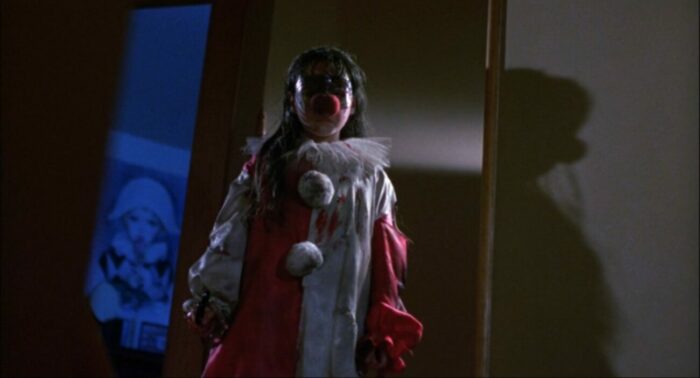
In Carpenter’s original 1978 script, whenever Michael is masked, he’s referred to as “The Shape,” which feels fitting given the original intent for Halloween to be an anthology. Carpenter’s first entry, the supernatural killer, was supposed to be a stand-alone film set to pave the way for others to create stories under the name Halloween, and thus why Season of the Witch exists under the namesake despite having nothing to do with Myers. Calling Myers “The Shape” makes even more sense if the supposed evil was meant to carry between films, as we were once likely meant to see other evil shapes as well.
Green’s Trilogy honors the idea of The Shape, not just as Myers, but as Corey, Laurie, Dr. Sartain, Tommy Doyle (Anthony Michael Hall), and the vicious nature of the Haddonfield community now living in the throes of a post-suburban malaise. The entire town becomes capable of dark, unsightly things, even if they’re not carrying a physical weapon to inflict harm. As we roar toward the conclusion, Halloween Ends doesn’t strike the right chord to make the town feel as dystopian as it intends as it opts to pass the torch. However, in its attempts to create a new shape, Corey’s character feels more like the Halloween-inspired Silent Night, Deadly Night’s final scene, where the ax falls to the feet of Billy’s brother Ricky. Corey also doles out punishment, but like Ricky in Silent Night, Deadly Night Part 2, it feels more like beta-inspired vindictiveness than his trauma that turns him into a monster.
And that’s what Halloween Ends winds up feeling like, another slasher movie sequel and one that particularly insists upon the recognition factor of totems from the Halloween multiverse. It’s funny, considering fans were told to disregard all of the Halloween films except the original and are instead treated to imagery and references from those films that have been wiped from the timeline. Don’t get me wrong; I love a lot of the Easter eggs. Still, what I think fans of these recurring reboots need to start asking themselves, after the generally unfavorable attitude both Kills and Ends carry with the fandom, is what they believe a successful legacy franchise will look like going forward. Is the embedded nostalgia helping or hurting the storytelling?

The Monsters Are Due In Haddonfield
Perhaps the most surprising transition between Halloween Kills and Halloween Ends is the kind of Laurie we encounter in the wake of Kills’ cliffhanger. Laurie was holed up in the woods planning for Myers’ return like a badass Linda Hamilton from Terminator 2, waiting for the machines to return. Recovering from PTSD and the trauma from the night He came home for the better part of the last four decades, Laurie, the character we saw vigilantly observing Myers’ transportation from the supermax psychiatric prison in Halloween 2018 while drinking and crying her shredded nerves into submission, is now a pie-burning grandma living domesticated in a bright red house with Allyson.
The house Laurie and Allyson now call home also somehow vaguely resembles the house her multiverse daughter Jamie (Danielle Harris) resides in during Halloween 4, which also tells you a lot about the arc of Halloween Ends. See, Green’s Trilogy of Halloween sequels does wonders for the fandom who were supposed to forget all Halloween’s original sequels. Yet somehow, Halloween Ends sends Curtis right back into that Everything Everywhere All at Once position with Laurie Strode. This film may canonically be Halloween 4 in Green’s universe, but there are references from every film prior to Halloween: H20 within the film. This timeline has provided Laurie a second chance with her daughter, Karen, and now, in Halloween Ends, her granddaughter, in a similar setting to where her abandoned daughter in an alternative timeline lived. Meanwhile, a transference act worthy of The Cult of Thorn has all but taken place between Michael and Corey. Christ, just give Corey a tramp stamp of the cult’s tattoo featured in Halloween: The Curse of Michael Myers, and we can roll our eyes already…but I digress.
Miles away from her burned-down cabin in the woods and living amongst locals who ridicule and resent her, Laurie has taken to overcoming her decades-long mental health battle by writing a memoir utilizing the Hemingway approach. This eyebrow-raising change is our first indication that all isn’t right in Halloween Ends. Though, to some extent, given the fandom for the character, I think the audience remains calm because their connection to Laurie implores them to wish for her happiness. Nevertheless, I think it’s hard to ask that viewers accept Laurie is no longer preparing for Michael to return one day, given the toll of the Kills finale.
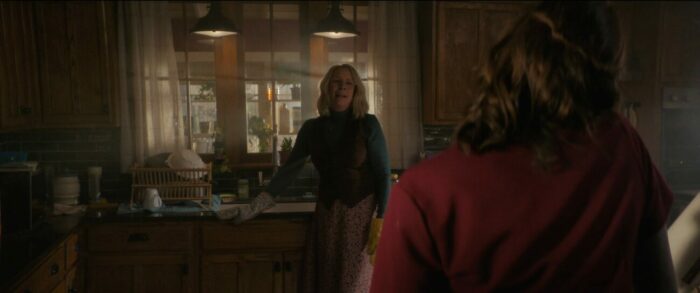
In Last year’s Halloween Kills, Laurie’s daughter Karen (Judy Greer) baited Michael away from Allyson and paid the ultimate price to keep her safe. Now, the timeline has reset. Now four years after the night he came home, the timeline has caught up with our current year, and apparently, the appropriate amount of time to pass for Laurie to adapt to a new lifestyle. While any therapist will flag this timeline and personality shift as suspicious, especially regarding the loss of her daughter, the audience accepts this reality for Laurie and Allyson under the caveat that Laurie can honor Karen’s wishes and protect what remains of her family.
Laurie’s personality shift can be summed up in one word: remorse. Laurie’s transformation from the badass from the 2018 film to the brown sweater-wearing reserved personality from 1978 is necessary for Halloween Ends, arcing her character from the monster her daughter Karen perceived her as and the reason Laurie wasn’t allowed around her granddaughter Allyson, to begin with. In Halloween Ends, attempting to honor her daughter’s wishes of not forcing that lifestyle upon her, Laurie pulls a one-eighty in the wake of Karen’s death, observing her requests not to project her fear and insecurity about Myers onto Allyson despite having been right about Myers’ return.
There’s also the remorse Laurie feels over the destruction of Haddonfield. We watch Laurie Strode as a shut-in, but when she does venture out to a local grocery store, we see another story unfold. There’s a quote from Stephen King that goes, “Monsters are real, and ghosts are real too. They live inside us, and sometimes, they win.” At the grocery store, this quote becomes wonderfully realized. First, with a run-in with former police officer Frank Hawkins (Will Patton), leaving Laurie hopeful and showing a flirtatious side to the character we haven’t seen since the semi-steamy makeout session with Adam Arkin in Halloween: H20. However, the glee she feels as she exits the supermarket is fleeting. Her smile withers as Laurie is haunted by the past. The sister of Laurie’s neighbor, who barely escaped the wrath of Michael Myers in Halloween Kills, berates Laurie for her smirk. All of them now know the force of nature Michael is, but Laurie is made to carry the burden of taunting the killer and exacerbating the already frenzied town. Laurie’s brief joy turns to shame, supplying her with the notion that she should be infinitely repentant.
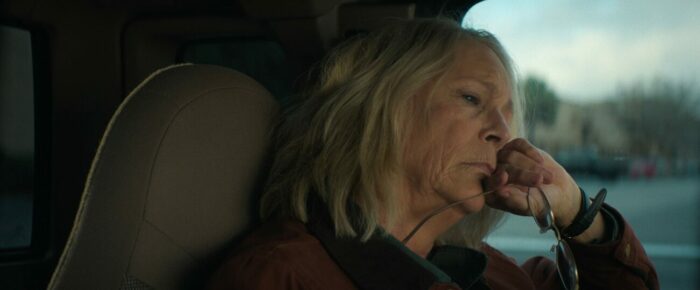
Adding to the instability, 94.9 WURG’s Willie the Kid (Keraun Harris) becomes the voice of uproar in the small town, shackling the citizens of an already fearful town on edge by reminding them of their past behavior and that one day when The Boogeyman returns. While the soundtrack he provides deserves some credit, Willie the Kid is just a lot of Fox News. A unique contrast voice to Adrienne Barbeau’s in Carpenter’s The Fog, who is actually trying to provide information during a supernatural event, Willie the Kid is a what-if machine, scaring citizens into staying tuned with those same fears that murder is coming soon to a suburb near you without ever offering more than a campfire tale’s amount of wisdom over a generalized sense of machismo. He tells his listeners that he’s prepared for a knife fight with Michael Myers, yet elevates the Myers myth beyond human limitations, a monster no one can contend with. Frankly, I love the allegory of a radio show inciting a riot for ratings, recalling the Pontypool sense of platform grandstanding while listeners think this persona is “truth-telling” as if it isn’t a business decision for financial gain.
Willie serves as the consumerist Silver Shamrock corporation incarnate, here to tell his listeners, “It’s four days ’til Halloween, Halloween, Halloween,” to promote his brand through panic and keep them glued to that dial. He doesn’t care if you live or die; you just have to listen to him. Ultimately, Willie talks a big game until his fast-talking tongue produces its final spin. He may only be a side character, but his arc is essential in this chronicle of Haddonfield. Plus, the audience gets to see The Last Drive-In’s Darcy the Mail Girl (Diana Prince) for a short yet enjoyable scream-queen howl.
Despite a final showdown between Laurie and Michael, Halloween Ends isn’t exactly about them. With the incorporation of an onslaught of characters, it becomes more apparent that Halloween Ends is about community, and because of that, Ends bakes a fair amount of politicism into its subtext through Willie’s fearmongering, his mythologizing of Myers, and his demonizing of both Laurie and Corey based on false information. But there’s also an element in Laurie’s initial reluctance to be a part of the town in Halloween 2018 to her attempt to integrate into it in Halloween Ends. This aspect of the Trilogy, her social outcasting in the wake of a love story, hints toward many suburban stereotypes through the years. The town’s resistance to accepting Laurie as a part of the community suggests every fabled right-wing Boogeyman that discourages racial, queer, or religious tolerance.
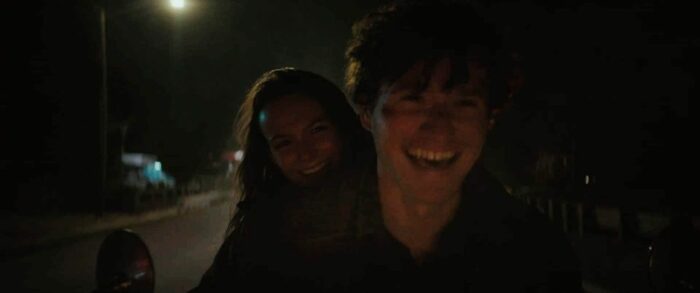
Violence begets violence, and the rhetoric from Willie helps keep the town chained to the good ol’ days of repression. For forty years, Laurie warned them that this day would come, but no one wanted to believe the face of Haddonfield was changing. This is why the nostalgic aspects of Halloween (2018) work. While the audience expects The Force Awakens, they receive a more politicized message about the dangers of expecting things to go unchanged. Haddonfield in Halloween Ends looks much different than that Mayberry-esque, Small Town, USA location with a mom-and-pop pharmacy on the corner we saw back in 1978. In Halloween Ends, it’s a larger and potentially seedier place mainly known for its Boogeyman reputation. Ends starts to feel episodic, like a character catalog of the lives living under the shadow of a past it will never overcome, chronicling the suffering townspeople, privileged kids, and high-ranking doctors offering promotions to nurses who make late-night house calls. It all comes together as if it’s primed for a little Lynchian weirdness, but character stories seem to overfill the time allotted.
Halloween Kills obliges the final film in Green’s Trilogy by helping audiences visualize the madness of Haddonfield’s upheaval. Still, Laurie’s shoot-first-and-ask-questions-later attitude helped develop the town’s bitter grudge against our final girl. Now, after the events of the Haddonfield riot, the town is looking to reattain its civilized status, desperate to believe that they could never be the kind of people to mobilize as a mob. As social commentary, this is what we witnessed as Capitol Hill insurgents have faced the consequences of their actions, and that’s what we’ve come to see in places where political activism and differences have turned violent. The town and Laurie now live with the memory of their actions. Laurie chooses accountability and lives as a pariah, receiving a plethora of finger-points and burning stares for being the example that led to the deaths of twenty-seven lives between Halloween (2018) and Halloween Kills. Succumbing to Tommy Doyle’s call, Haddonfield saw itself at its almost absolute worst and made Laurie a scapegoat synonymous with Myers’ wrath.
I say the town was almost at its worst because I believe this honor is reserved for the final act of Halloween Ends. Myers’ body is tied to the top of Laurie’s car, paraded through the streets with a police escort, and arrives at a chop shop with a metal shredding machine. The body is carried like a crowd-surfing fan at an arena concert and dropped into the mangler, forever ridding Haddonfield of the curse that is Michael Myers. While every person watching understands why this is necessary, it still somehow feels shocking.
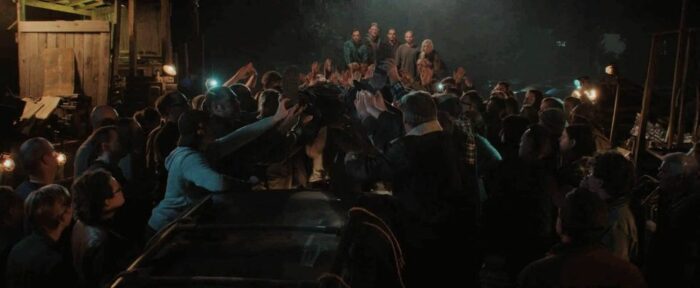
As I watched and identified some of the political themes, this transgressive act hit hard, and I’ll always wonder whether or not Haddonfield lost its humanity in the process. I thoroughly understand the aggravation in the Capitol insurrection, the lack of justice for Brionna Taylor, George Floyd, and the countless victims of other racially charged deaths by police, and the false information surrounding Covid-19 and both the 2016 and 2020 elections. I think, in some way, that Green and the rest of the writers thought this wasn’t just supposed to be cathartic for the townspeople, but for us too. A way to literally kill evil and breathe a sigh of relief. In this way, Green is making a statement that doing nothing can also be an evil act. Since Michael represents the evil in the world, inaction here would imply sentencing Haddonfield to another bout of terror in the future.
I suppose I expected any repercussions Michael would face in Halloween Ends would always have been severe, but the ending almost sets up the events of A Nightmare on Elm Street, where Myers’ death could likely be kept as a town secret. You know, the kind you take to the grave and never tell your children about. However, what if it’s the opposite? What if we look at it through another lens, and it marks the end of an era? Haddonfield can move on from the Boogeyman, the hate, the pointing fingers, the radio platforms pushing a narrative and perhaps prosper in a post-Michael-Myers future, free of fear and the stigma of being the home of the Boogeyman. While it serves as a nice nod to a film that likely took some inspiration from Carpenter’s Halloween, it also infers how growing political extremism is the real suburban decay, insisting that we’ve moved far beyond locked doors and high fences and have become monsters ourselves to the neighbors around us.
A Universal Monster?
In last year’s Halloween Kills, the Haddonfield townspeople didn’t respond the same way they would have in 1981, though the result turned out to be the same. There was mayhem and confusion, and the townspeople were left shocked and victimized by Michael despite their rallying cries of “evil dies tonight.” In fact, Halloween Kills tries extremely hard to take Michael Myers and place him in Frankenstein’s monster’s seat. Maybe Universal was angling for a modern monster movie, but the film that first came to mind when I watched Halloween Kills the first time was The Bride of Frankenstein.
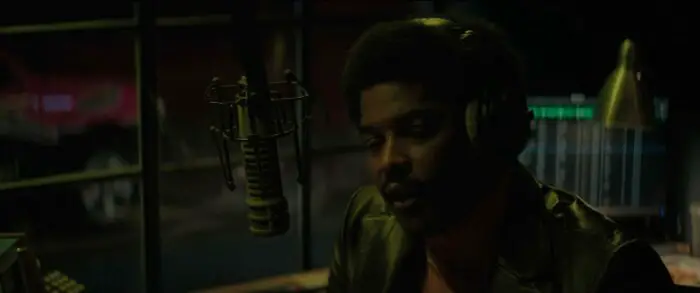
Hear me out.
A large portion of The Bride of Frankenstein revolves around the misunderstood monster on the run in a small town where the humanity of the townspeople is the highlighted monstrosity. In mirrored focus, Haddonfield becomes the center of Halloween Kills’ attention. However, after now having seen the whole Trilogy play out, it’s clear this was only a small portion of a much larger opus. The Bride of Frankenstein ends with The Monster condemning himself, The Bride, and Dr. Pretorius to death. Throughout Green’s Halloween saga, Michael, Laurie, and a few interchangeable players fall into these character archetypes, ostensibly showing us how history can repeat itself if we’re unwilling to change.
Michael is the anti-Frankenstein monster. He is evil, malicious, deliberate, and far from being misunderstood. Though sliding an actual vicious creature into the universe of a benevolent one is always a beautiful concept. Though Laurie doesn’t meet her end in her final confrontation with Michael, I still think of Laurie as The Bride. A monstrous love story of rejection spanning forty years. Obviously, some creeps can’t take a hint. As Candyman would ask Helen in the original film, “Be my victim,” there’s something that initially attracts Michael to Laurie. Whether you believe it’s all random or not, you have to remember that Michael chooses Laurie when she drops the key off at his house for her realtor father. From there, she’s stalked for an entire day. When he finally does get her alone, after slaughtering all of her friends (leaving her no ground to run to) and driving the kids she’s babysitting screaming out the front door, she refuses his butcher’s knife but puts up a fight he was never expecting.
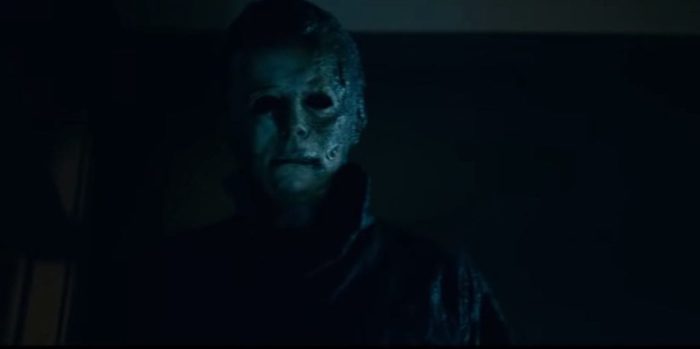
I’ve always thought of Michael Myers as a harvester of souls in a way, especially in Carpenter’s original film. Laurie also suggests as much in Halloween Kills, saying, “the more he kills, the more he transcends.” This explains why Corey lures victims for Michael in Ends, but one could also ponder the theory of pleasure. The way he stalks Laurie throughout the films infers a psycho-sexual connotation, and, given the context that all his other victims in the original are horny teenagers, is there some inference that Michael is also getting his rocks off? I suppose that includes the potentially incestual overtones he may have harbored for his sister, Judith. When Laurie leveled the playing field in 2018, she became the hunter and, in turn, accepted a date with the devil. As Frankenstein’s Monster only wanted friendship and love, this evil semi-sexual opposing viewpoint is more in line with extreme domestic violence.
On that note, Corey and Allyson’s romantic scenes become dizzyingly frustrating for an audience anticipating a film where Haddonfield is on fire in the background of a Mortal Kombat-style brawl between Michael and Laurie, complete with the iconic voice yelling “Finish Him” or “Finish Her.” However, these scenes arguably add to the theory that Michael loves pursuing Laurie and perhaps vice-versa. Allyson and Corey’s relationship is a metaphor for Michael’s magnetism to Laurie, and the overall allegory of the Strode women being drawn to violence. Laurie, after all, sets Allyson up with Corey in the first place.
However, unlike The Bride, Laurie doesn’t meet her fate. Instead, her daughter, Karen, does. Tommy, former sheriff Brackett (Charles Cyphers), and Karen are murdered in Halloween Kills’ finale, somehow stopping Michael for the next four years. Karen fills the Bride’s role because the two lovers, Henry and Elizabeth Frankenstein, are told to live by the monster, allowing Officer Hawkins and Laurie the potential to continue a past romance.
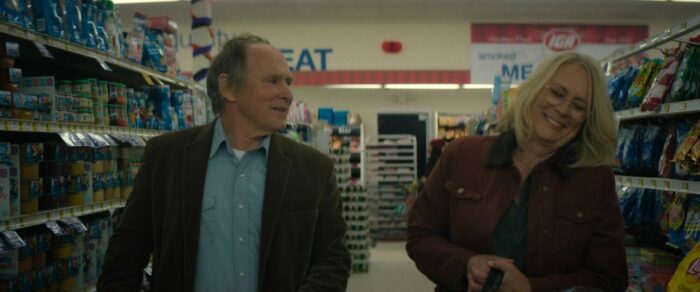
Finally, Pretorius uses Frankenstein’s creation, suggesting friendship but only wanting to create a new species of monster-like people. Pretorius may have initially been reserved for Dr. Sartain’s character in Halloween 2018, especially in the inspirational sense. While Tommy mostly fits the Burgomaster/Mayor character: friendly at the bar, knows everybody, and can easily rile them up to head out into the streets for the “Evil Dies Tonight” parade. Yet, he could easily attain a similar Pretorius arc as a schemer of free drinks from the townies as he tells his war stories about the night he spent under Laurie’s care in 1978. He effectively uses the monster to get what he wants, eventually turning the townspeople into an army of monsters through his duality as the Burgomaster character. Tommy may be the easiest character to identify in this parallel which helps unlock the understanding of David Gordon Green’s entire Trilogy because, as we see in Halloween Ends, intentions, just like evil, are constantly changing.
Rewatching the original 1931 Frankenstein recently and examining it while crafting this essay, I came to realize director James Whale’s depiction of Mary Shelley’s themes also fit the gaze of David Gordon Green’s creation of Corey. Much of Halloween Ends is shrouded in mirroring the suburban moral decay with an odd focus through Rebel Without a Cause’s lens, harkening back to the original Halloween’s storyline of teenage sex and home invasion in a vastly different seventies setting than their parents imagined as they drove away from the overcrowding cities in the ’40s and ’50s. Corey Callahan is our James Dean, arrested in the first act, resenting his bickering parents, going toe-to-toe opposing privileged kids, and getting Allyson to ride on his motorbike. However, that may align more with the brief real-life romance of Rebel’s Natalie Wood and motorcycle enthusiast Steve McQueen.
The metaphor of teenage sex being a death sentence is a slasher staple that Halloween (1978) helped make mainstream. But it’s also a creative callback to McQueen’s 1958 leading-man debut, The Blob. It’s possibly the first story of small-town deviance being met with horror consequences when teens visiting “Lovers’ Lane” see a meteorite crash nearby after sharing a kiss. The Blob, of course, becomes a gigantic all-consuming entity, moving through the city collecting people and becoming a fascinating analogy for venereal diseases and sex with multiple partners. However, it’s the end of the film, when the entity is brought to the arctic, that recalls the end of Shelley’s Frankenstein novel as well as the Polar Expedition Six crew that discovers The Thing from Another World.

Diverting back to how Halloween Ends fits the themes of Shelley’s tome, look no further than Corey’s relationship with his mother. Frankenstein is an allegorical fantasy about creationism and abandonment that stems from Shelley’s misfortunes with miscarriages, the death of her child, and post-partum depression, resulting in a story steeped in guilt and loss, but most importantly, defying nature. Whale only captures a fraction of Shelley’s atmosphere, and the book and film are very different beasts, but the connective tissue of all three is the worry of being a bad parent.
Whenever Corey’s mother, Joan (Joanne Baron), is on screen, she’s helicopter parenting, barking at her son or husband (and, in one case, Laurie) and attempting to control Corey’s every action throughout the day. At one point, she even grounds Corey, despite him clearly being a grown man in his twenties. Frankenstein shares equivalent scenes, with Henry attempting to teach the monster, failing, and inevitably running away from his laboratory. That lack of patience and understanding, as well as over-regulating and jockeying for control over another being, leaves the monster to venture out and discover the world on his own, despite being an infant in a nine-foot-tall body as Corey is treated like an infant in a twenty-year-old’s body.
The fragility of life is also explained through these monsters’ inaugural victims. Yet, Frankenstein’s Monster remains innocent after killing a small daisy-picking child because he’s never been taught right from wrong. Michael and Corey carry a dark affection for killing after their inaugural murders of their own young victims. Michael, having been a child himself, may have never had conversations regarding morals, though his age and the likelihood of education suggest otherwise. While Dr. Loomis once assessed Michael as being pure evil, Corey is the Holden Caulfield of slashers, rebelling against his parents, who will never be able to see him for more than a child killer, and the town where he doesn’t fit in. In contrast to Laurie, Corey becomes precisely what society has seen him as.
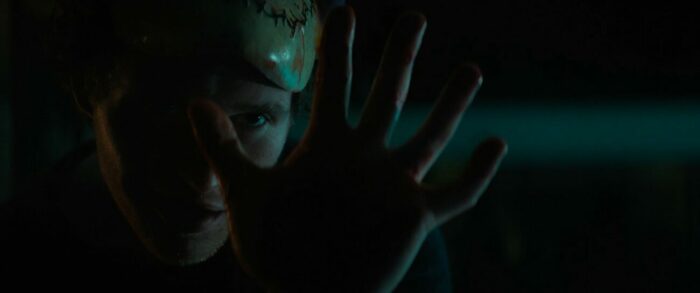
Allyson, in some regards, fits a similar mold. She asks Laurie for space at the beginning and argues for her grandmother to stop when Laurie begins reverting to that more militant Sarah Connor type of character from Halloween 2018. Respecting Karen’s wishes, Laurie shows Allyson similar consideration by letting her make her own mistakes, despite knowing full well what Corey is.
Defying Expectations
Like most people, I anticipated the ending of Halloween Kills to be a game-changer for this Trilogy. I didn’t hate Kills, and I’ve likely defended it more for, at the very least, delivering on telling you exactly what to expect in its title. The movie sidelined Laurie almost entirely, letting Curtis have only a fraction of the screen time from the previous film. The town’s story was a different perspective that had been dying to be told since 1981. Yet, I thought it would remain the bridge between the two more substantial pillars.
As I’ve already discussed, the townspeople of Halloween Kills had become a bloodthirsty mob, and while that is comparable to the carnage that occurs in 1981’s Halloween II, it operates differently in retrospect. The panic rising in their idyllic heartland community costs an innocent trick-or-treater their life due to the heightened anxiety of a police force ill-equipped to deal with the threat of a serial killer. In the no-longer-cannon sequel, Loomis cocks and aims his gun every three minutes, and the excitement of hunting for Myers leads to anarchy. A boy dressed similarly to Myers gets chased into the street, getting struck by a car, which then explodes as it, along with the boy’s body, careens into another vehicle. Yet despite the unrest and the horror of chaos in Halloween II, the narrative shifts to the empty hospital while Kills travels the road not taken, staying mired in the mob-filled streets.
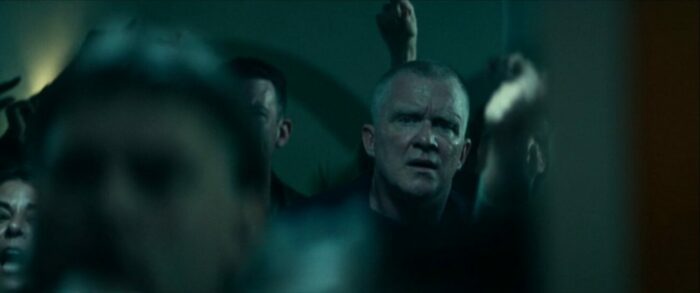
After the ending of Halloween (2018) left the three Strode women riding triumphantly in the back of a pickup truck to the hospital, with Laurie chanting, “Let it Burn!” while firefighters made their way into her backwoods deathtrap, I think, like me, fans were prepared for Green’s second entry to be similar to the Empire Strikes Back template, and suspected the good guys wouldn’t win this chapter. Karen’s death was heaviest, further compounded by the loss of Tommy and the old Sheriff. But, character-wise, none of these characters outside of Karen felt rounded out enough to reproduce the heartbreak of Han being frozen in carbonite and Luke losing his hand. And as we prepared for Halloween Ends, I think fan expectations were on par with a slasher movie equivalent of a WWE ladder match.
Instead, we got Corey, another character we didn’t know and hadn’t previously spent time with during the Trilogy. When he comes upon Myers hiding in a sewer, protected by an elderly man, it all feels very Halloween V: The Revenge of Michael Myers, where Michael is nursed back to health by another older gentleman living in a salt mine. However, Halloween Ends tacks on a Dexter subplot of Corey wanting to be Myers’ apprentice. Seriously, how many times did Dexter Morgan (Michael C. Hall) try that, and how many times did it end in kill-or-be-killed scenarios? All of them. Okay, just checking. The outcome of this partnership was never in question, and the web of subplots it becomes convoluted amongst acts as a lackluster undercard of filler, keeping us from the fight we came to see.
Did Rob Zombie set the stage for Ends?
Corey’s declaration for Michael Myers to teach him his ways had lackluster Dimension sequel of the early 2000s smeared all over it. Corey begins feeding Michael victims in the sewer, and why Myers doesn’t just instantly off him as well is slightly outlandish. However, this brings up my harvester of souls idea from earlier, and well, just maybe, this is how Michael reattains his power. When we see the burned mask on Michael, we’re made to remember how he walked out of Laurie’s burning cabin and was beaten on by the townspeople. There’s also a throwaway line about Myers escaping a fire at his house that Halloween, which has since been bulldozed. Regardless, his inhuman stamina, or how it works, was never called into question until now. As Kills sidelined Laurie, it became apparent that Ends was sidelining Michael. At this point, I started to make comparisons to the Rob Zombie Halloween films, which, while more streamlined, resonate on Green’s Trilogy’s beats.
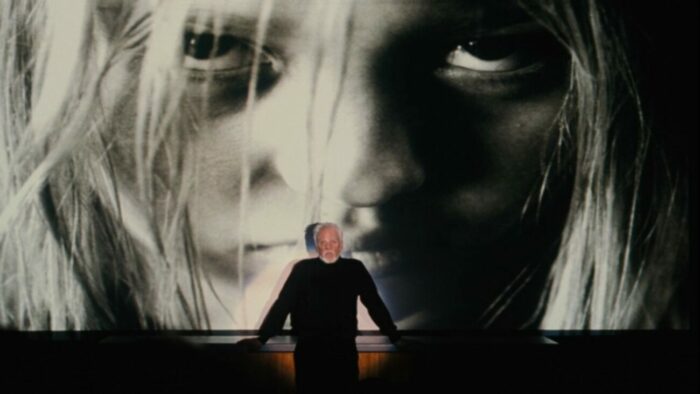
In Rob Zombie’s 2007 Halloween remake, we received more backstory as Michael transformed from the troubled boy who murdered his sister into the relentless monster we’ve come to fear. Some had issues accepting Zombie’s exposition, which provided reason and motivation to cloud the original concept that Carpenter’s Halloween was a more random encounter that could happen to anyone. I thought Zombie’s first film was an intricate examination of nature vs. nurture that, while it may not have been We Need to Talk About Kevin, was a psychological take we hadn’t had and a brutally realized addition to what was once the established Halloween lore. While a fiercely passionate fanbase exists that Laurie and Michael aren’t related, there’s a whole other universe of seven films that suggest otherwise. What Green really did with his new Trilogy was undo the events of the TV cut of Halloween, which made Laurie Michael’s baby sister, events later made canon by Halloween II.
On the other hand, Rob Zombie’s Halloween II jumps the shark a little bit, utilizing a bleak and action-packed dream sequence through a hospital that echoes Laurie’s experience in the 1981 edition of Halloween II. The ruse and subsequent psychological artifices of Rob Zombie’s Halloween II were enough to make me upset watching the film in the theater some years ago. Witnessing Scout Taylor Compton’s Laurie in possession of Myers’ mask, succumbing to images of her mother and pale horses, it was easy to feel cheated. The Pale Horse is a biblical omen, suggesting Laurie is Death, ready to kill “with sword, with hunger, and with the beasts of the Earth” (Revelations 6:7-8). The Pale Horse exists throughout the film, teasing the not-so-hidden twist. Films between 2000-2010 were filled with unreliable narrators thanks to 1999’s Fight Club re-pioneering the twist Psycho first gave us, while films like American Psycho and High Tension followed. Those fairly decent films aside, horror became lousy with this psychological finale for the better part of the decade. Zombie’s Halloween sequel may have suffered more because of viewer apathy.
Besides Zombie’s not-so-subtle metaphor, Halloween Ends utilizes a similar idea. Curtis’ Laurie becomes the next Boogeyman to Haddonfield, and all of the murders caused by Myers that ensue through the movies are now attributed to Laurie’s own post-traumatic stress. David Gordon Green suggests more subtly the same thing Rob Zombie did a bit more bluntly: evil doesn’t die; it only changes shape.
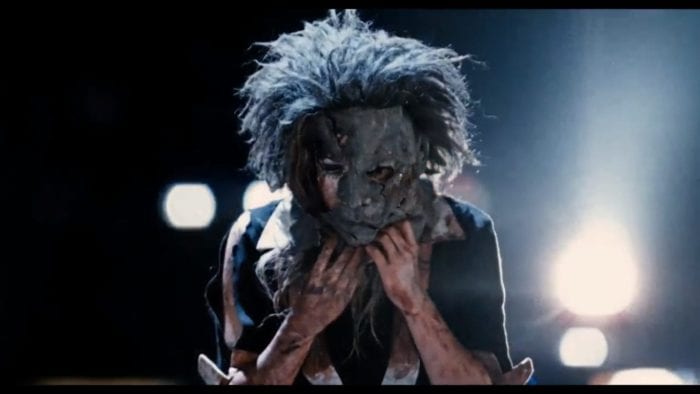
Final Thoughts
Halloween: H20 turned 24 this year, and I still get chills every time I see Curtis’ face meet Michael’s mask through the porthole window pane on the door. I used to have nightmares of being trapped in Myers’ body on the other side of the door, a passenger watching and fulfilling the actions of an inhuman monster, feeling every stab, gouge, and claw Laurie made in her efforts to defeat the monster that pursued her. When I watched the trailer for Halloween Ends this past summer, I felt an extreme sense of parallelism, believing that the images of the fight scene held an uncanny similarity while subtly suggesting the power of evil through “The Shape.” Honestly, it excited me because it felt like someone had seen those nightmares and choreographed a film around them. Unfortunately, that wasn’t so much the case. The result was not as good as the trailer, which realistically used much of the film’s last half an hour to advertise a battle royale 40 years in the making, a fight that wasn’t nearly as satisfying as the 2018 siege on Laurie’s cabin.
Like many, I believe Green’s Halloween Trilogy rests far from the experience imagined when leaving the theater after its first installment in 2018. However, I think some of the derailment of the last two films lies in the Trilogy’s insistence on nostalgia. Did we need Laurie to appear in the same outfit, sweater and all, from the 1978 film? Probably not, but it was an enjoyable callback.
Reboots are an uphill battle for creators trying to blend new ideas while attempting to appease fans of the source material. Green, McBride, Fradley, Scott Teems, Paul Brad Logan, Chris Bernier, and all of the cast and crew wanted to create something for fans that served the horror community as something more than just an ordinary slasher film. Instead, Halloween Ends’ storyline gets clouded as the cleverness of the script’s subtext gets as mangled as Myers’ body through an overt amount of fanservice and its introduction of too many characters. That isn’t to say that Rohan Campbell isn’t acting his ass off here, but the script asks for way too much from Campbell’s Corey, and the overall feeling is that Green’s Trilogy should have either been a miniseries or cut some characters for time.
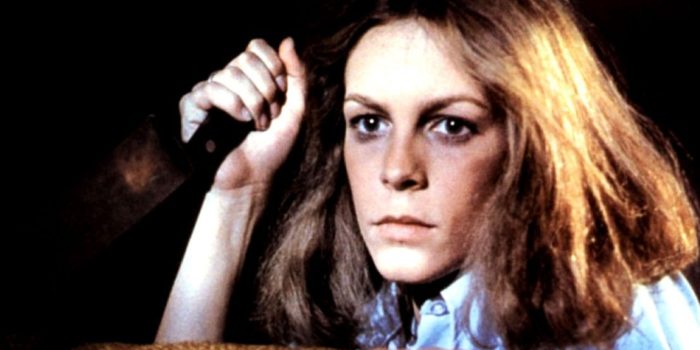
As I stated at the beginning, I think there’s a lot beneath the surface of Halloween Ends and this Trilogy, and probably even more than I’ve been able to comprise in this piece. There are brilliant themes and underlying inferences here, from generations of women fighting the malicious forces of unscrupulous men to musings on violence, the synonymous nature of doing nothing, and the impact hate-fueled rhetoric can have on influencing a community. It may not be the slasher trilogy I expected or hoped for, but I absolutely respect it and suspect that I’ll see it differently, changing shape, so to speak, every time I watch it.
Regardless of how you may feel about any of Green’s Halloween films, you really have to praise Jamie Lee Curtis. For forty-four years and seven Halloween movies, she’s been the magnetic force of the franchise and remains an absolute legend in horror. Thank you, Jamie Lee Curtis, for all your contributions to the Halloween franchise. While unlikely, I hope Curtis decides to return to this sandbox in some capacity, but if not, I’m sure it will be okay. I believe it’s time to start telling new Halloween stories and perhaps attempt to reinvent the Boogeyman. The Halloween Trilogy leaves the door open for a unique, new “Shape” to crawl through, but what will emerge could be anyone’s guess.
___________________________________
Halloween Ends is currently playing in theaters, available to purchase on VOD, and streaming exclusively on Peacock. Pre-orders for physical 4K, Blu-Ray, and DVD copies are available through your preferred physical media stores.



